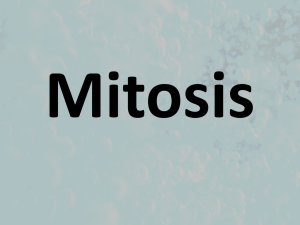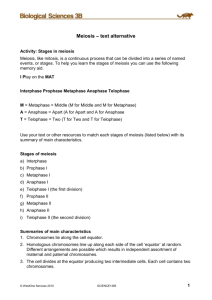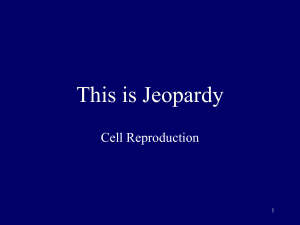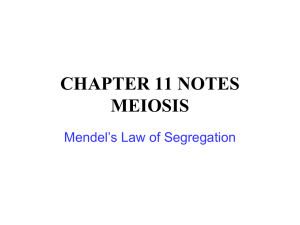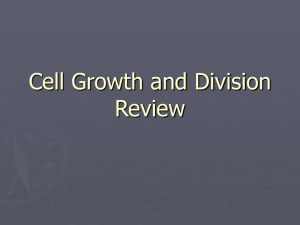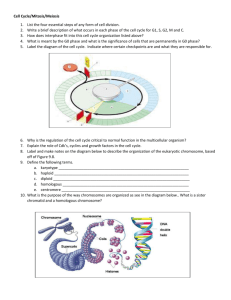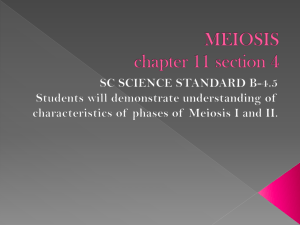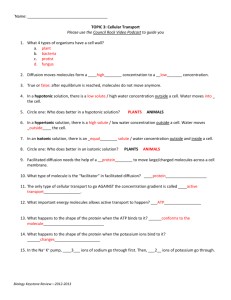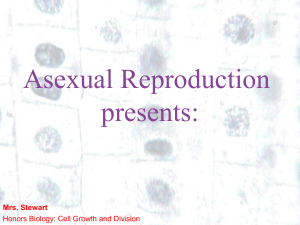MITOSIS PRACTICE PROBLEMS- ANSWERS
advertisement
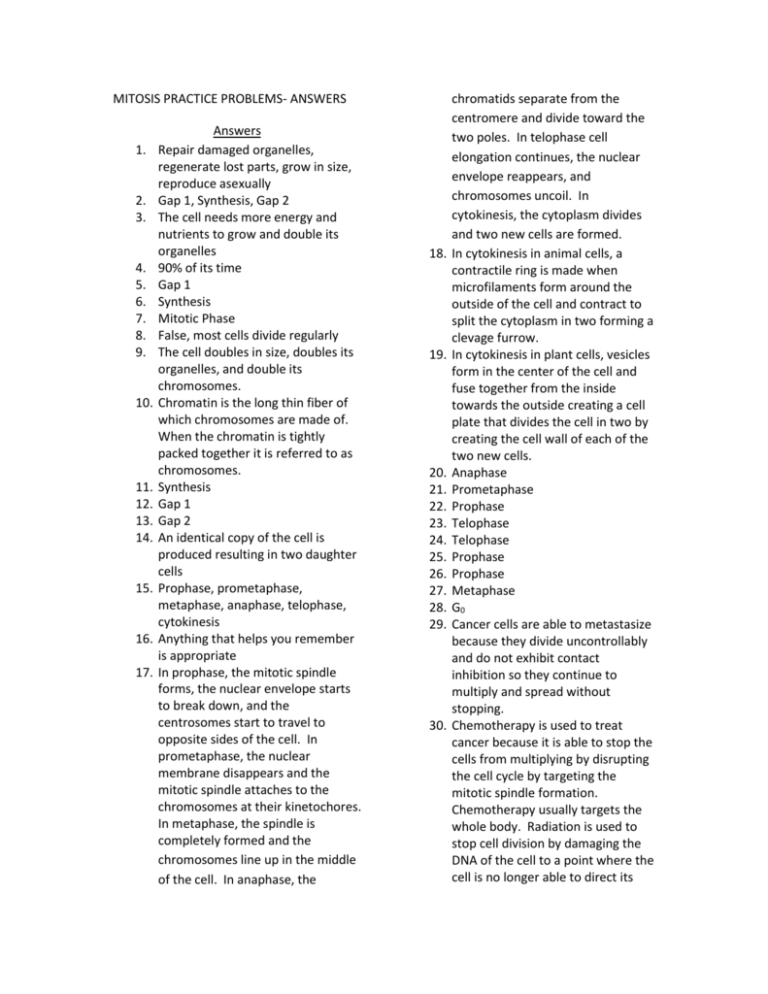
MITOSIS PRACTICE PROBLEMS- ANSWERS 1. 2. 3. 4. 5. 6. 7. 8. 9. 10. 11. 12. 13. 14. 15. 16. 17. Answers Repair damaged organelles, regenerate lost parts, grow in size, reproduce asexually Gap 1, Synthesis, Gap 2 The cell needs more energy and nutrients to grow and double its organelles 90% of its time Gap 1 Synthesis Mitotic Phase False, most cells divide regularly The cell doubles in size, doubles its organelles, and double its chromosomes. Chromatin is the long thin fiber of which chromosomes are made of. When the chromatin is tightly packed together it is referred to as chromosomes. Synthesis Gap 1 Gap 2 An identical copy of the cell is produced resulting in two daughter cells Prophase, prometaphase, metaphase, anaphase, telophase, cytokinesis Anything that helps you remember is appropriate In prophase, the mitotic spindle forms, the nuclear envelope starts to break down, and the centrosomes start to travel to opposite sides of the cell. In prometaphase, the nuclear membrane disappears and the mitotic spindle attaches to the chromosomes at their kinetochores. In metaphase, the spindle is completely formed and the chromosomes line up in the middle of the cell. In anaphase, the 18. 19. 20. 21. 22. 23. 24. 25. 26. 27. 28. 29. 30. chromatids separate from the centromere and divide toward the two poles. In telophase cell elongation continues, the nuclear envelope reappears, and chromosomes uncoil. In cytokinesis, the cytoplasm divides and two new cells are formed. In cytokinesis in animal cells, a contractile ring is made when microfilaments form around the outside of the cell and contract to split the cytoplasm in two forming a clevage furrow. In cytokinesis in plant cells, vesicles form in the center of the cell and fuse together from the inside towards the outside creating a cell plate that divides the cell in two by creating the cell wall of each of the two new cells. Anaphase Prometaphase Prophase Telophase Telophase Prophase Prophase Metaphase G0 Cancer cells are able to metastasize because they divide uncontrollably and do not exhibit contact inhibition so they continue to multiply and spread without stopping. Chemotherapy is used to treat cancer because it is able to stop the cells from multiplying by disrupting the cell cycle by targeting the mitotic spindle formation. Chemotherapy usually targets the whole body. Radiation is used to stop cell division by damaging the DNA of the cell to a point where the cell is no longer able to direct its 31. 32. 33. 34. 35. 36. 37. 38. 39. 40. 41. 42. 43. own growth. Radiation can be used to target specific areas. Benin tumors are typically not life threatening, as they do not usually spread. Malignant tumors are considered life threatening as they cause damage to surrounding areas through metastasis. You can recognize skin cancer by checking your moles using ABCDE. A for asymmetry, B for border that is irregular, C for having multiple colors, D for diameter larger than a pencil eraser, and E for enlarging. Chemotherapy drugs typically cause patients to lose their hair because they interrupt the growth cycle of all rapidly dividing cells, which includes hair cells. Somatic cells Homologous chromosomes are two chromosomes, one from each parent, that share the same shape and loci for controlling the same inherited traits Gametes Females: eggs; Males: sperm Chromosome Duplication 2; Meiosis I and Meiosis II Prophase I, Prometaphase I, Metaphase I, Anaphase I, Telophase I, Cytokinesis I, Prophase II, Prometaphase II, Metaphase II, Anaphase II, Telophase II, Cytokinesis II By being identical twins Crossing over Maternally and paternally inherited homologous chromosomes move opposite poles. 44. 45. 46. 47. 48. 49. 50. 51. 52. 53. 54. 55. 56. 57. 58. 59. 60. 61. 62. 63. 64. 65. 46 23 2 That gametes have one set of 23 chromosomes with no homologous pairs 4 haploid daughter cells 46 23 The pairing of homologus chromosomes in prophase I Crossing Over Each homologous chromosome separates on its own without the influence of the other homologous chromosomes of that gamete. Therefore many different assortments can be made. Non-disjunction Trisomy 21 Incorrect chromosome number The eggs of an older woman will have been in meiosis longer and therefore having more of a chance for non-disjunction to occur. Y Plants Polyploidy which is too many sets of chromosomes and aneuploidy which is the addition of or lack of a chromosome XY XX A photographic representation of all the homologous pairs of chromosomes in an organism Humans Intelligence and Fertility Free Response 1. a. The three sub-phases of interphase are Gap 1 (G1), Synthesis (S), and gap 2 (G2). During G1 the cell grows and duplicates its organelles. During the S phase the cell replicates its DNA, doubling the number of chromosomes it has in preparation for cell division. During G2 the cell continues preparation for division by producing the proteins it will need. b. The cell has checkpoints before G1, G2, and mitosis to determine whether or not the cell should proceed with division. Fully differentiated (specialized) cells like muscle cells and brain cells are said to be stuck at point G0 because the checkpoint at G1 prevents these types of cells from undergoing further cell divisions. a. A rapidly dividing cell, like a skin cell, would undergo multiple divisions and likely spend less than 90% of its life in interphase. 2. a. Meiosis is the process by which a germ cell divides and reduces the original number of chromosomes in each cell by half. Meiosis consists of two divisions Meiosis I and Meiosis II. During Meiosis I homologous chromosomes shuffle genes and then are separated from one another, resulting in two diploid cells with unique genetic information. During Meiosis II, the sister chromatids of each cell are separated from one another, resulting in 4 cells total, each with a haploid number of genetically unique chromosomes. b. Two processes that allow for variation in sexually reproducing organisms are crossing-over and Independent Assortment. During Prophase I of Meiosis I homologous chromosomes form tetrads and exchange portions of their genetic material, crossing-over at the chiasma site. During Metaphase I homologous chromosomes line up on the metaphase plate segregate randomly and separate from one another - this shuffling of genes is called Independent Assortment.. Independent Assortment and crossing over ensure that each sex cell contains unique new combinations of genetic material that allows for variation in sexually reproducing organisms. 3. a. Prophase, prometaphase, metaphase, anaphase, telophase, cytokinesis b. Left to right, top to bottom Condensing, phases, chromosomes, prophase, prometaphase, metaphase, anaphase, telophase, DNA strands, histones, sister chromatids, cytokinesis, centromeres, 2 daughter cells 4. a. Prior to the start of meiosis and mitosis, the number of chromosomes in the original parent cell is doubled. However, the daughter cells produced by meiosis each contain a haploid set of unique genetic information because the process involves two divisions and the chromosomes are randomly shuffled and recombined before the first division. In mitosis, the cell only divides once, separating sister chromatids with identical genetic information into the two different nuclei, ensuring that each daughter cell contains the same number of identical chromosomes. 5. a. a. Possibilities include polyploidy, trisomy, monosomy, nondisjunction, anueploidy b. b. Polyploidy – wheat, bananas, etc.; trisomy and monosomy – humans; etc. c. c. Polyploidy is beneficial to some organisms, but fatal in humans; trisomy and monosomy are both harmful, but not always fatal. 6. a. a. Cancer cells can destroy healthy tissue, so stem cells could be used to replace damages tissue. b. The two most common methods of treating cancer are chemotherapy and radiation. Chemotherapy targets mitotic spindle formation in all dividing cells in the body, which results in death of healthy cells as well as cancerous cells. Radiation therapy causes mutations in the cancer cells of a tumor, but the effects of radiation, even when targeted, may still cause mutations in healthy cells.
